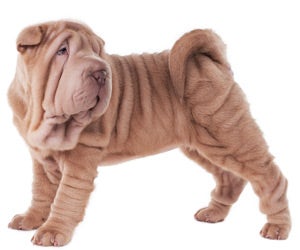Shar-Pei
-
Overview
The Shar-Pei was bred in China to protect the royal family and entertain them in dog fights. Their wrinkly skin and prickly coat protected them during fighting. Their characteristic scowl makes them look almost more like a hippopotamus than a dog.
The Shar-Pei is a noble, self-possessed dog with an independent personality. Still, with careful training, he can become a fiercely loyal, affectionate dog who will need some help socializing and keeping himself clean.
-
Personality
-
Coat Care

Grooming with a rubber brush or mitt occasionally will help the Shar-Pei's coat stay clean and give it a light sheen, but the brushing requirements are not excessive.
The biggest challenge Shar-Pei owners face is keeping the folds of their dog's skin clean. Frequent bathing will allow bacteria and wetness to irritate the wrinkles, so baths should be infrequent. Always use a gentle, sensitive dog shampoo and make sure the Shar-Pei dries completely after every bath.
Clipping or trimming your dog’s coat is far easier than you would ever imagine. With the right clipper, trimmer and scissors, giving your dog a haircut is easy on your wallet and your schedule.
Most dogs with short coats generally require occasional trims and tidying up in areas of excessive hair growth with trimmers or blunt scissors. It's always wise to take a dog for a short walk or exercise to calm them down before trimming. Remember to brush the coat first to remove tangles and mats. Use a trimmer or a scissors to even out areas around the tail, paws, sanitary areas and chest, as needed. When finished, the coat should lay flat and smooth against the body of most short-haired dogs.
Many dog owners are apprehensive about trimming their dog’s nails because they are nervous about cutting into the quick. But with the right conditioning and careful cutting, nail clipping can be a simple, stress-free activity for you and your dog.
Provide your dog with plenty of positive reinforcement and even treats to help associate nail clipping with a positive experience. As you start to clip, gently press on your dog’s paws to help him become accustomed to the feeling of having his nails clipped. Then, work gradually, shaving down just a thin portion of the nail at first to make sure you don’t reach the quick. Clip one nail, reward your dog with a treat, and stop to give him some positive reinforcement before moving on. Gradually increase the number of nails you clip in one sitting to help your dog get used to the process. Never trim extremely long nails down to a short nail in one sitting, because this is an excellent way to accidently quick the dog’s nail. Instead, work gradually, shaving small portions of your dog’s nails off each time.
You can tell if you’re getting close to the quick by the texture of your dog’s nail. The nail is hard closer to the surface and becomes softer as you get closer to the quick. If your dog’s nail starts to feel softer, that’s a good indication that you’re getting close to the quick.
Not all breeds and coat styles require routine trimming in and around the eyes and ears but all should undergo regular inspection and cleaning around these sensitive areas. Doing so will help prevent the development of infections that could seriously damage these amazing organs.
It is always important to routinely clean your dog's eyes and ears, and examine for potential infections. Some short-coated dogs, like hounds and mastiffs, have large, sensitive ears that should be checked weekly for infection and cleaned with a cotton ball. Gently wipe a cotton ball moistened with mineral oil, olive oil or witch hazel in your dog's ear, being careful to avoid the ear canal. Never use a Q-Tip, which could cause damage to the inner ear if your dog suddenly shakes or jerks his head. Bushy hair growth within the ear can be thinned with tweezers or blunt scissors. Use a small trimmer to trim excess hair around the eyes, ears and face. If you have a small dog, like an Pug, take special care to clean around their eyes with a cotton ball or soft cloth and use a small trimmer to trim excess hair around their eyes to make sure they are comfortable. Dogs with facial wrinkles, like Pugs and Dogues de Bordeaux, be wiped down at least weekly to prevent infection.
Many owners do not realize how important it is to brush your pet’s teeth on a regular basis. Some dogs are prone to dental problems and sensitive teeth, especially small dogs with tiny teeth and dogs with special diets. These problems can be easily combatted with frequent brushing.
Cavities are rare with dogs but gum disease caused by tartar buildup is not, which is why they require regular brushing with toothpaste and a toothbrush formulated specifically for dogs. While daily brushing is ideal, doing so on a weekly basis will be a big help in avoiding the need to bring your dog to a veterinarian for a cleaning, which usually has to be done under sedation.

 India (English)
India (English)
 Middle East and Africa (English)
Middle East and Africa (English)
 South Africa (English)
South Africa (English)
 Australia (English)
Australia (English)
 Japan (日本語)
Japan (日本語)
 South East Asia (English)
South East Asia (English)
 Singapore (English)
Singapore (English)
 Europe (English)
Europe (English)
 United Kingdom (English)
United Kingdom (English)
 Argentina (Español)
Argentina (Español)
 Brazil (Portuguese)
Brazil (Portuguese)
 Colombia (Español)
Colombia (Español)
 Latin America (Español)
Latin America (Español)
 México (Español)
México (Español)
 Chile (Español)
Chile (Español)
 Peru (Español)
Peru (Español)
 Canada (English)
Canada (English)

